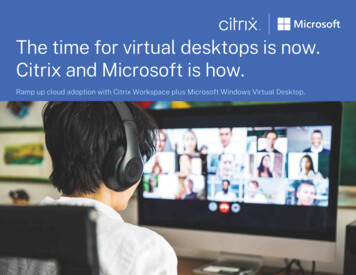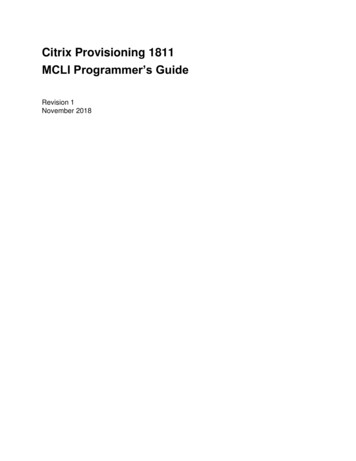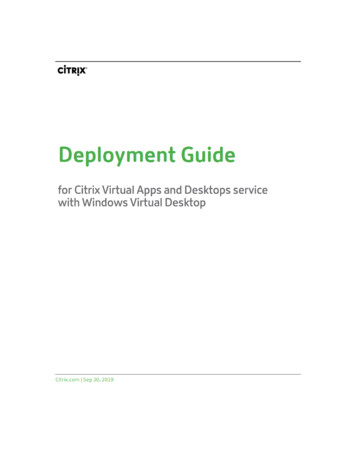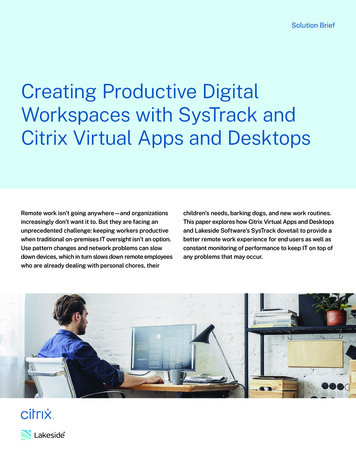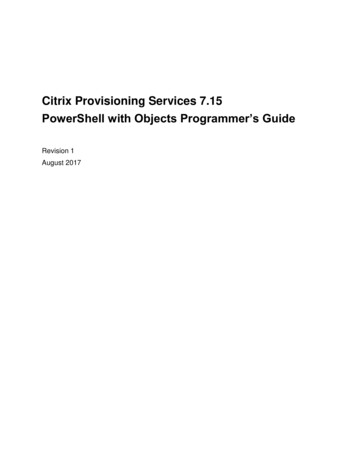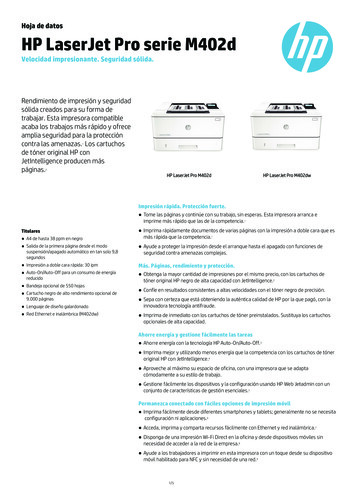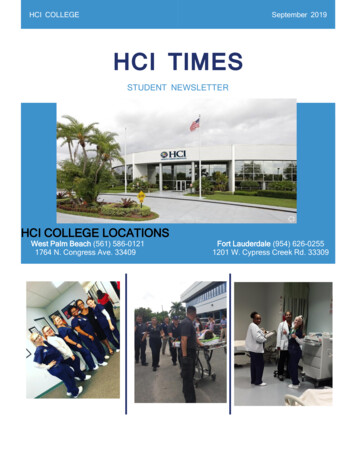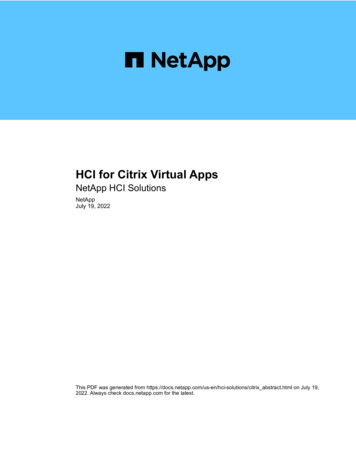
Transcription
HCI for Citrix Virtual AppsNetApp HCI SolutionsNetAppJuly 19, 2022This PDF was generated from https://docs.netapp.com/us-en/hci-solutions/citrix abstract.html on July 19,2022. Always check docs.netapp.com for the latest.
Table of ContentsTR-4854: NetApp HCI for Citrix Virtual Apps and Desktops with Citrix Hypervisor . . . . . . . . . . . . . . . . . . . . . . . 1Abstract . . . . . . . . . . . . . . . . . . . . . . . . . . . . . . . . . . . . . . . . . . . . . . . . . . . . . . . . . . . . . . . . . . . . . . . . . . . . . . 1Solution Overview . . . . . . . . . . . . . . . . . . . . . . . . . . . . . . . . . . . . . . . . . . . . . . . . . . . . . . . . . . . . . . . . . . . . . . 1Physical Infrastructure . . . . . . . . . . . . . . . . . . . . . . . . . . . . . . . . . . . . . . . . . . . . . . . . . . . . . . . . . . . . . . . . . . . 2Citrix Hypervisor . . . . . . . . . . . . . . . . . . . . . . . . . . . . . . . . . . . . . . . . . . . . . . . . . . . . . . . . . . . . . . . . . . . . . . . . 7Resource Layer . . . . . . . . . . . . . . . . . . . . . . . . . . . . . . . . . . . . . . . . . . . . . . . . . . . . . . . . . . . . . . . . . . . . . . . 19Control Layer . . . . . . . . . . . . . . . . . . . . . . . . . . . . . . . . . . . . . . . . . . . . . . . . . . . . . . . . . . . . . . . . . . . . . . . . . 25Access Layer . . . . . . . . . . . . . . . . . . . . . . . . . . . . . . . . . . . . . . . . . . . . . . . . . . . . . . . . . . . . . . . . . . . . . . . . . 31User Layer . . . . . . . . . . . . . . . . . . . . . . . . . . . . . . . . . . . . . . . . . . . . . . . . . . . . . . . . . . . . . . . . . . . . . . . . . . . 33NetApp Value . . . . . . . . . . . . . . . . . . . . . . . . . . . . . . . . . . . . . . . . . . . . . . . . . . . . . . . . . . . . . . . . . . . . . . . . . 34Appendix iSCSI Device Configuration. . . . . . . . . . . . . . . . . . . . . . . . . . . . . . . . . . . . . . . . . . . . . . . . . . . . . . 34Where to Find Additional Information . . . . . . . . . . . . . . . . . . . . . . . . . . . . . . . . . . . . . . . . . . . . . . . . . . . . . . . 35
TR-4854: NetApp HCI for Citrix Virtual Apps andDesktops with Citrix HypervisorSuresh Thoppay, NetAppNetApp HCI infrastructure allows you to start small and build in small increments to meet the demands ofvirtual desktop users. Compute or storage nodes can be added or removed to address changing businessrequirements.Citrix Virtual Apps and Desktops provides a feature-rich platform for end-user computing that addressesvarious deployment needs, including support for multiple hypervisors. The premium edition of this softwareincludes tools to manage images and user policies.Citrix Hypervisor (formerly known as Citrix Xen Hypervisor) provides additional features to Citrix Virtual Appsand Desktops compared to running on other hypervisor platforms. The following are key benefits of running onCitrix Hypervisor: A Citrix Hypervisor license is included with all versions of Citrix Virtual Apps and Desktops. This licensinghelps to reduce the cost of running the Citrix Virtual Apps and Desktops platform. Features like PVS Accelerator and Storage Accelerator are only available with Citrix Hypervisor. For Citrix solutions, the Citrix Hypervisor is the preferred workload choice. Available in Long Term Service Release (LTSR; aligns with Citrix Virtual Apps and Desktops) and CurrentRelease (CR) options.AbstractThis document reviews the solution architecture for Citrix Virtual Apps and Desktops with Citrix Hypervisor. Itprovides best practices and design guidelines for Citrix implementation on NetApp HCI. It also highlightsmultitenancy features, user profiles, and image management.Solution OverviewService providers who deliver the Virtual Apps and Desktops service prefer to host it onCitrix Hypervisor to reduce cost and for better integration. The NetApp DeploymentEngine (NDE), which performs automated installation of VMware vSphere on NetAppHCI, currently doesn’t support deployment of Citrix Hypervisor. Citrix Hypervisor can beinstalled on NetApp HCI using PXE boot or installation media or other deploymentmethods supported by Citrix.Citrix Virtual Apps and Desktops can automate the provisioning of desktops and session hosts either usingCitrix Provisioning (network-based) or by Machine Creation Services (hypervisor storage-based). BothMicrosoft Windows-based OSs and popular Linux flavors are supported. Existing physical workstations,desktop PCs, and VMs on other hypervisors that are not enabled for auto-provisioning can also be madeavailable for remote access by installing the agents.The Citrix Workspace Application, a client software used to access Virtual Apps and Desktops, is supported onvarious devices including tablets and mobile phones. Virtual Apps and Desktops can be accessed using abrowser-based HTML5 interface internally or externally to the deployment location.1
Based on your business needs, the solution can be extended to multiple sites. However, remember thatNetApp HCI storage efficiencies operate on a per-cluster basis.The following figure shows the high-level architecture of the solution. The access, control, and resource layersare deployed on top of Citrix Hypervisor as virtual machines. Citrix Hypervisor runs on NetApp HCI computenodes. The virtual disk images are stored in the iSCSI storage repository on NetApp HCI storage nodes.A NetApp AFF A300 is used in this solution for SMB file shares to store user profiles with FSLogix containers,Citrix profile management (for multisession write-back support), Elastic App Layering images, and so on. Wealso use SMB file share to mount ISO images on Citrix Hypervisor.A Mellanox SN2010 switch is used for 10/25/100Gb Ethernet connectivity. Storage nodes use SFP28transceivers for 25Gb connection, compute nodes use SFP/SFP transceivers for 10Gb connection, andinterswitch links are QSFP28 transceivers for a 100Gb connection.Storage ports are configured with multichassis link aggregation (MLAG) to provide total throughput of 50Gband are configured as trunk ports. Compute node ports are configured as hybrid ports to create a VLAN foriSCSI, XenMotion, and workload VLANs.Physical InfrastructureNetApp HCINetApp HCI is available as compute nodes or storage nodes. Depending on the storage node model, aminimum of two to four nodes is required to form a cluster. For the compute nodes, a minimum of two nodesare required to provide high availability. Based on demand, nodes can be added one at a time to increasecompute or storage capacity.A management node (mNode) deployed on a compute node runs as a virtual machine on supportedhypervisors. The mNode is used for sending data to ActiveIQ (a SaaS-based management portal), to host ahybrid cloud control portal, as a reverse proxy for remote support of NetApp HCI, and so on.2
NetApp HCI enables you to have nondistributive rolling upgrades. Even when one node is down, data isserviced from the other nodes. The following figure depicts NetApp HCI storage multitenancy features.NetApp HCI Storage provides flash storage through iSCSI connection to compute nodes. iSCSI connectionscan be secured using CHAP credentials or a volume access group. A volume access group only allowsauthorized initiators to access the volumes. An account holds a collection of volumes, the CHAP credential,and the volume access group. To provide network-level separation between tenants, different VLANs can beused, and volume access groups also support virtual routing and forwarding (VRF) to ensure the tenants canhave same or overlapping IP subnets.A RESTful web interface is available for custom automation tasks. NetApp HCI has PowerShell and Ansiblemodules available for automation tasks. For more info, see NetApp.IO.Storage NodesNetApp HCI supports two storage node models: the H410S and H610S. The H410 series comes in a 2Uchassis containing four half- width nodes. Each node has six SSDs of sizes 480GB, 960GB, or 1.92TB with theoption of drive encryption. The H410S can start with a minimum of two nodes. Each node delivers 50,000 to100,000 IOPS with a 4K block size. The following figure presents a front and back view of an H410S storagenode.3
The H610S is a 1U storage node with 12 NVMe drives of sizes 960GB, 1.92TB, or 3.84TB with the option ofdrive encryption. A minimum of four H610S nodes are required to form a cluster. It delivers around 100,000IOPS per node with a 4K block size. The following figure depicts a front and back view of an H610S storagenode.In a single cluster, there can be a mix of storage node models. The capacity of a single node can’t exceed 1/3of the total cluster size. The storage nodes come with two network ports for iSCSI (10/25GbE – SFP28) andtwo ports for management (1/10/GbE – RJ45). A single out-of-band 1GbE RJ45 management port is alsoavailable.Compute NodesNetApp HCI compute nodes are available in three models: H410C, H610C, and H615C. Compute nodes are allRedFish API-compatible and provide a BIOS option to enable Trusted Platform Module (TPM) and IntelTrusted eXecution Technology (TXT).The H410C is a half-width node that can be placed in a 2U chassis. The chassis can have a mix of computeand storage nodes. The H410C comes with first-generation Intel Xeon Silver/Gold scalable processors with 4to 20 cores in dual-socket configurations. The memory size ranges from 384GB to 1TB. There are four10/25GbE (SFP28) ports and two 1GbE RJ45 ports, with one 1GbE RJ45 port available for out-of-bandmanagement. The following figure depicts a front and back view of an H410C compute node.4
The H610C is 2RU and has a dual- socket first generation Intel Xeon Gold 6130 scalable processor with 16cores of 2.1GHz, 512GB RAM and two NVIDIA Tesla M10 GPU cards. This server comes with two 10/25GbESFP28 ports and two 1GbE RJ45 ports, with one 1GbE RJ45 port available for out-of-band management. Thefollowing figure depicts a front and back view of an H610C compute node.The H610C has two Tesla M10 cards providing a total of 64GB frame buffer memory with a total of 8 GPUs. Itcan support up to 64 personal virtual desktops with GPU enabled. To host more sessions per server, a shareddesktop delivery model is available.The H615C is a 1RU server with a dual socket for second-generation Intel Xeon Silver/Gold scalableprocessors with 4 to 24 cores per socket. RAM ranges from 384GB to 1.5TB. One model contains threeNVIDIA Tesla T4 cards. The server includes two 10/25GbE (SFP28) and one 1GbE (RJ45) for out-of-bandmanagement. The following figure depicts a front and back view of an H615C compute node.5
The H615C includes three Tesla T4 cards providing a total of 48GB frame buffer and three GPUs. The T4 cardis a general-purpose GPU card that can be used for AI inference workloads as well as for professionalgraphics. It includes ray tracing cores that can help simulate light reflections.Hybrid Cloud ControlThe Hybrid Cloud Control portal is often used for scaling out NetApp HCI by adding storage or/and computenodes. The portal provides an inventory of NetApp HCI compute and storage nodes and a link to the ActiveIQmanagement portal. See the following screenshot of Hybrid Cloud Control.NetApp AFFNetApp AFF provides an all-flash, scale-out file storage system, which is used as a part of this solution.ONTAP is the storage software that runs on NetApp AFF. Some key benefits of using ONTAP for SMB filestorage are as follows: Storage Virtual Machines (SVM) for secure multitenancy NetApp FlexGroup technology for a scalable, high-performance file system NetApp FabricPool technology for capacity tiering. With FabricPool, you can keeping hot data local andtransfer cold data to cloud storage).6
Adaptive QoS for guaranteed SLAs. You can adjusts QoS settings based on allocated or used space. Automation features (RESTful APIs, PowerShell, and Ansible modules) Data protection and business continuity features including NetApp Snapshot, NetApp SnapMirror, andNetApp MetroCluster technologiesMellanox SwitchA Mellanox SN2010 switch is used in this solution. However, you can also use other compatible switches. Thefollowing Mellanox switches are frequently used with NetApp HCI.ModelRack UnitSFP28 (10/25GbE)portsQSFP (40/100GbE)portsAggregateThroughput .2SN2700Full-width–326.4QSFP ports support 4x25GbE breakout cables.Mellanox switches are open Ethernet switches that allow you to pick the network operating system. Choicesinclude the Mellanox Onyx OS or various Linux OSs such as Cumulus-Linux, Linux Switch, and so on.Mellanox switches also support the switch software development kit, the switch abstraction interface (SAI; partof the Open Compute Project), and Software for Open Networking in the Cloud (SONIC).Mellanox switches provide low latency and support traditional data center protocols and tunneling protocols likeVXLAN. VXLAN Hardware VTEP is available to function as an L2 gateway. These switches support variouscertified security standards like UC API, FIPS 140-2 (System Secure Mode), NIST 800-181A (SSH ServerStrict Mode), and CoPP (IP Filter).Mellanox switches support automation tools like Ansible, SALT Stack, Puppet, and so on. The WebManagement Interface provides the option to execute multi-line CLI commands.Citrix HypervisorCitrix Hypervisor (formerly known as XenServer) is the industry-leading, cost-effective,open-source platform for desktop virtualization infrastructure. XenCenter is a light-weightgraphical management interface for Citrix Hypervisor servers. The following figurepresents an overview of the Citrix Hypervisor architecture.7
Citrix Hypervisor is a type-1 hypervisor. The control domain (also called Domain 0 or dom0) is a secure,privileged Linux VM that runs the Citrix Hypervisor management tool stack known as XAPI. This Linux VM isbased on a CentOS 7.5 distribution. Besides providing Citrix Hypervisor management functions, dom0 alsoruns the physical device drivers for networking, storage, and so on. The control domain can talk to thehypervisor to instruct it to start or stop guest VMs.Virtual desktops run in the guest domain, sometimes referred as the user domain or domU, and requestresources from the control domain. Hardware-assisted virtualization uses CPU virtualization extensions likeIntel VT. The OS kernel doesn’t need to be aware that it is running on a virtual machine. Quick Emulator(QEMU) is used for virtualizing the BIOS, the IDE, the graphic adapter, USB, the network adapter, and so on.With paravirtualization (PV), the OS kernel and device drivers are optimized to boost performance in the virtualmachine. The following figure presents multitenancy features of Citrix Hypervisor.8
Resources from NetApp HCI makes up the hardware layer, which includes compute, storage, network, GPUs,and so on.ComputeThe CPU and memory details of NetApp HCI are covered in the previous section. However, this sectionfocuses on how the compute node is utilized in the Citrix Hypervisor environment.Each NetApp HCI compute node with Citrix Hypervisor installed is referred as a server. A pool of servers ismanaged as a resource pool (RP). The resource pools are created with similar model compute nodes toprovide similar performance when the workload is moved from one node to another. A resource pool alwayscontains a node designated as master, which exposes the management interface (for XenCenter and the CLI)and which can be routed to other member servers as necessary. When high availability is enabled, master reelection takes place if the master node goes down.A resource pool can have up to 64 servers (soft limit). However, when clustering is enabled with the GFS2shared storage resource, the number of servers is restricted to 16.The resource pool picks a server for hosting the workload and can be migrated to other server using the LiveMigration feature. To load balance across the resource pool, the optional WLB management pack must beinstalled on Citrix Hypervisor.9
Each tenant resource can be hosted on dedicated resource pools or can be differentiated with tags on thesame resource pool. Custom values can be defined for operational and reporting purpose.StorageNetApp HCI compute nodes have local storage that is not recommended for the storage of any persistent data.Such data should be stored on an iSCSI volume created with NetApp HCI storage or can be on NFS datastoreon NetApp AFF.To use NetApp HCI storage, iSCSI must be enabled on Citrix Hypervisor servers. Using the iQN, register theinitiators and create access groups on the Element management portal. Create the volumes (remember toenable 512e block size support for LVM over iSCSI SR) and assign the account ID and access group.The iSCSI initiator can be customized using the following command on the CLI:10
xe host-param-set uuid valid host id otherconfig:iscsi iqn new initiator iqnMultipathing of iSCSI is supported when multiple iSCSI NICs are configured. iSCSI configuration is performedusing XenCenter or by using CLI commands like iscsiadm and multipath. This configuration can also beperformed with the various Citrix Hypervisor CLI tools. For iSCSI multipath for single target storage arrays, seeCTX138429.A storage repository (SR) is the storage target in which virtual machine (VM) virtual disk images (VDIs) arestored. A VDI is a storage abstraction that represents a virtual hard disk drive (HDD). The following figuredepicts various Citrix Hypervisor storage objects.The relationship between the SR and host is handled by a physical block device (PBD), which stores theconfiguration information required to connect and interact with the given storage target. Similarly, a virtual blockdevice (VBD) maintains the mapping between VDIs and a VM. Apart from that, a VBD is also used for finetuning the quality of service (QoS) and statistics for a given VDI. The following screenshot presents CitrixHypervisor storage repository types.11
With NetApp HCI, the following SR types can be created. The following table provides a comparison offeatures.FeatureLVM over iSCSIGFS2Maximum virtual disk image size2TiB16TiBDisk provisioning methodThick ProvisionedThin ProvisionedRead-caching supportNoYesClustered pool supportNoYes12
FeatureKnown constraintsLVM over iSCSI Read caching not supportedGFS2 VM migration with storage livemigration is not supported forVMs whose VDIs are on aGFS2 SR. You also cannotmigrate VDIs from another typeof SR to a GFS2 SR. Trim/unmap is not supported onGFS2 SRs. Performance metrics are notavailable for GFS2 SRs anddisks on these SRs. Changed block tracking is notsupported for VDIs stored onGFS2 SRs. You cannot export VDIs thatare greater than 2TiB as VHDor OVA/OVF. However, you canexport VMs with VDIs largerthan 2TiB in XVA format. Clustered pools only support upto 16 hosts per pool.With the current features available in NetApp HCI, the Intellicache feature of Citrix Hypervisor is not of value toNetApp HCI customers. Intellicache improves performance for file-based storage systems by caching data in alocal storage repository.Read caching allows you to improve performance for certain storage repositories by caching data in servermemory. GFS2 is the first iSCSI volume to support read caching.NetworkCitrix Hypervisor networking is based on Open vSwitch with support for OpenFlow. It supports fine grainsecurity policies to control the traffic sent and receive from a VM. It also provides detailed visibility about thebehavior and performance of all traffic sent in the virtual network environment. The following figure presents anoverview of Citrix Hypervisor networking.13
The physical interface (PIF) is associated with a NIC on the server. With Network HCI, up to six NICs areavailable for use. With the model, which only has two NICs, SR-IOV can be used to add more PIFs. The PIFacts as an uplink port to the virtual switch network. The virtual interface (VIF) connects to a NIC on virtualmachines.Various network options are available: An external network with VLANs A single server private network with no external connectivity Bonded network (active/active – aggregate throughput) Bonded network (active/passive – fault tolerant) Bonded network (LACP – load balancing based on source and destination IP and port) Bonded network (LACP – load balancing based on source and destination mac address) Cross-server private network in which the network does not leave the resource pool SR-IOVThe network configuration created on the master server is replicated to other member servers. Therefore,when a new server is added to the resource pool, its network configuration is replicated from the master.You can only assign one IP address per VLAN per NIC. For iSCSI multipath, you must havemultiple PIFs to assign an IP on the same subnet. For H615C, you can consider SR-IOV foriSCSI.14
Because the network on Citrix Hypervisor is based on Open vSwitch, you can manage it with ovs-vsctl andovs-appctl commands. It also supports NVGRE/VXLAN as an overlay solution for large scale- outenvironments.When used with Citrix Provisioning (PVS), PVS Accelerator improves performance by caching Domain 0memory or by combining memory and a local storage repository.15
GPUCitrix Hypervisor was the first to deploy NVIDIA vGPUs, a virtualization platform for GPUs, enabling the sharingof GPU across multiple virtual machines. NetApp HCI H610C (with NVIDIA Tesla M10 cards) and H615C (withNVIDIA Tesla T4 cards) can provide GPU resources to virtual desktops, providing hardware acceleration toenhance the user experience.A NetApp HCI GPU can be consumed in a Citrix Hypervisor environment by using pass- through mode, wherethe whole GPU is presented to a single virtual machine, or it can be consumed using NVIDIA vGPU. Livemigration of a VM with GPU pass through is not supported, and therefore NVIDIA vGPU is the preferredchoice.NVIDIA Virtual GPU Manager for Citrix Hypervisor can be deployed along with other management packs byusing XenCenter or it can be installed using an SSH session with the server. The virtual GPU gets its owndedicated frame buffers, while sharing the streaming processors, encoder, decoder and so on. It can also becontrolled using a scheduler.The H610C has two Tesla M10 graphic cards, each with 4 GPUs per card. Each GPU has 8GB of frame buffermemory with a total of 8 GPUs and 64GB of memory per server. H615C has three Tesla T4 cards, each with itsown GPU and 16GB frame buffer memory with a total of 3 GPUs and 48GB of graphic memory per server. Thefollowing figure presents an overview of the NVIDIA vGPU architecture.16
NVIDIA vGPU supports homogenous profiles for each GPU. The placement of virtual machines on a GPU iscontrolled by a policy that sets either maximum density or maximum performance in response to demand.When creating a VM, you can set a virtual GPU profile. The vGPU profile you chose is based on the framebuffer memory level needed, the number of displays, and the resolution requirement. You can also set the17
purpose of a virtual machine, whether it be virtual apps (A), virtual desktops (B), a professional Quadro virtualworkstation (Q), or compute workloads (C) for AI inferencing applications.Independently from XenCenter, the CLI utility on the Citrix Hypervisor nvidia-smi can be used to troubleshootand for monitoring the performance.The NVIDIA driver on a virtual machine is required to access the virtual GPU. Typically, the hypervisor driverversion and the VM guest driver should have the same vGPU release version. But, starting with vGPU release10, the hypervisor can have the latest version while the VM driver can be the n-1 version.SecurityCitrix Hypervisor supports authentication, authorization, and audit controls. Authentication is controlled by localaccounts as well as by Active Directory. Users and groups can be assigned to roles that control permission toresources. Events and logging can be stored remotely in addition to on the local server.Citrix Hypervisor supports Transport Layer Security (TLS) 1.2 to encrypt the traffic using SSL certificates.Because most configuration is stored locally in an XML database, some of the contents, like SMB passwords,are in clear text, so you must protect access to the hypervisor.Data ProtectionVirtual machines can be exported as OVA files, which can be used to import them to other hypervisors. Virtualmachines can also be exported in the native XVA format and imported to any other Citrix Hypervisor. Fordisaster recovery, this second option is also available along with storage- based replication handled by18
SnapMirror or native Element OS synchronous or asynchronous replication. With NetApp, HCI storage canalso be paired with ONTAP storage for replication.Storage-based snapshot and cloning features are available to provide crash-consistent image backups.Hypervisor-based snapshots can be used to provide point-in-time snapshots and can also be used astemplates to provision new virtual machines.Resource LayerComputeTo host virtual apps and desktop resources, a connection to a hypervisor and resource details should beconfigured in Citrix Studio or with PowerShell. In the case of Citrix Hypervisor, a resource pool master nodeDNS or IP address is required. For a secure connection, use HTTPS with SSL certificates installed on theserver. Resources are defined with selection the of storage resources and networks.When additional compute capacity is required, a hypervisor server can be added to existing resource pool.Whenever you add a new resource pool and you need to make it available for hosting virtual apps anddesktops, you must define a new connection.A site is where the SQL database resides and is known as the primary zone. Additional zones are added toaddress users in different geographic locations to provide better response time by hosting on local resources.A satellite zone is a remote zone that only has hypervisor components to host virtual apps or desktops withoptional delivery controllers.Citrix Provisioning also uses the connection and resources information when using the Citrix Virtual DesktopsSetup Wizard.19
StorageThe storage repository for Virtual Apps and Desktops is controlled using the connection and resources coveredin the section Compute. When you define the resource, you have the option to pick the shared storage andenable Intellicache with Citrix Hypervisor.20
There is also an option to pick resources for the OS, the personal vDisk, and temporary data. When multipleresources are selected, CItrix Virtual Apps and Desktops automatically spreads the load. In a multitenantenvironment, a dedicated resource selection can be made for each tenant resource.21
Citrix Provisioning requires an SMB file share to host the vDisks for the devices. We recommend hosting thisSMB share on a FlexGroup volume to improve availability, performance, and capacity scaling.22
FSLogixFSLogix allows users to have a persistent experience even in non-persistent environments like pooled desktopdeployment scenarios. It optimizes file I/O between the virtual desktops and the SMB file store and reduceslogin time. A native (local) profile experience minimizes the tasks required on the master image to set up userprofiles.FSLogix keeps user settings and personal data in its own container (VHD file). The SMB file share to store theFSLogix user profile container is configured on a registry that is controlled by group policy object. Citrix UserProfile Management can be used along with FSLogix to support concurrent sessions with virtual desktops at23
the same time on virtual apps.This figure shows the content of the FSLogix SMB location. Note that we switched the directory name to showthe username before the security identifier (sid).NetworkVirtual Apps and Desktops require a connection and resources to host, as covered in the section Compute.When defining the resource, pick the VLANs that must be associated with the resource. During machinecatalog deployment, you are prompted to associate the VM NIC to the corresponding network.24
GPUAs indicated in the previous section, when you determine whether the hypervisor server has a GPU resource,you are prompted to enable graphics virtualization and pick the vGPU profile.Control LayerApp LayeringLayering is a technology to separate the OS, applications, and user settings and data, each hosted on its ownvirtual disks or group of virtual disks. These components are then merged with the OS as if they were all onsame machine image. Users can continue with their work without any additional training. Layers make it easyto assign, patch, and update. A layer is simply a container for file system and registry entries unique to thatlayer.Citrix App Layering allows you to manage master images for Citrix Virtual Apps and Desktops as well as for theVMware Horizon environment. App layering also allows you to provision applications to users on demand;these apps are attached while logging in. The user personalization layer allows users to install custom appsand store the data on their dedicated layer. Therefore, you can have a personal desktop experience even whenyou are using a shared desktop model.Citrix App Layering creates merged layers to create the master image and does not have any additionalperformance penalty. With Elastic Layers, the user login time increases.Citrix App Layering uses a single virtual appliance to manage the layers and hands off using the image andapplication delivery to another platform. The Citrix Enterprise Layer Manager (ELM) portal must be accessedfrom web browsers that supports Microsoft Silverlight 4.0. A cloud- based management portal is also availableif local management interface requirements cannot be met.Initial configuration includes the creation of platform connectors of two types; the first is a platform connectorfor layer creation, and the other is a
For Citrix solutions, the Citrix Hypervisor is the preferred workload choice. Available in Long Term Service Release (LTSR; aligns with Citrix Virtual Apps and Desktops) and Current Release (CR) options. Abstract This document reviews the solution architecture for Citrix Virtual Apps and Desktops with Citrix Hypervisor. It
